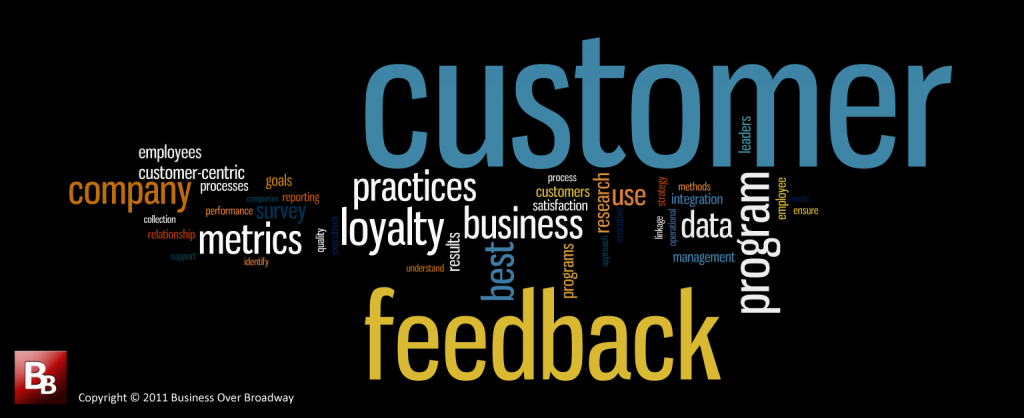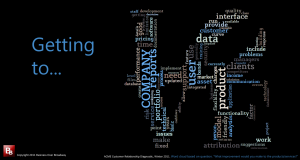
Customer Experience Management (CEM) programs are complex, data intensive programs. To be successful, you need to effectively communicate information about that program to important stakeholders, including employees, partners, and customers. We know that loyalty leading companies communicate customer initiatives throughout the company, from top executives to front-line employees. For example, in a best practices study on customer feedback programs, I found that loyalty leading companies, compared to loyalty lagging companies, communicate a lot about their CEM program, including its goals, processes and results.
Information Needs
Communications about the CEM program need to be tailored to specific audiences’ needs. Communication of CEM elements to other stakeholders (employees, partners and customers) looks a lot different as their needs are different. To build a company around the customer, communication to other constituencies needs to help to communicate two things: 1) what’s important to customers and 2) What you are doing to improve the customer experience.
1. What Matters to the Customers
To build a company around the customer and their needs, each employee and partner need to know which customer touch points are important. Knowing what’s important to customers, employees are better equipped to deliver a customer experience that meets or exceeds the customers’ expectations. Senior executives, for example, receive the results of driver analysis which helps them in strategic decision making. The front-line employees could receive individual customer results as well as aggregated customer results. This micro and macro level of reporting ensures employees understand specific customer concerns as well as customer concerns on a wider scale.

Getting to Love word cloud for ACME. Based on customer responses to the question "What improvements would you make to the products/services?"
Be sure to make CEM results interesting. Bar charts are boring. I know because I make them. Consider employing the use of word clouds to summarize the customers’ open-ended comments. Word clouds let you present frequency data in a fun, interesting way. Depending how the customer survey question is phrased, the resulting word cloud have different meanings. For example, a word cloud based on the question “What improvements would you make to the products/service?” would help employees understand that the key business areas that are important to customers. Additionally, a word cloud based on the question “What would you say to somebody considering purchasing our products/solutions?” would help employees understand how to better market and sell solutions. Check out these examples of word clouds you could use as a starting point for your CEM program.
2. What You are Doing to Improve the Customer Experience
Companies collect customer feedback in order to make customer experience improvements in areas that matter to the customers. Oftentimes, these improvements come in the form of process and operational changes that impact a large group of customers. Keep track of these operational changes and share them with different constituencies. For each change, keep track of the reasons behind the change (driven by the company or driven by customer feedback) to optimize their use as examples in marketing collateral or customer communications.
The list of changes reflect specific systemic changes designed to improve the customer experience. When creating this list, be specific in your description. Don’t just say, “Improved marketing process.” Instead, a more precise approach includes the specific problem being addressed, the expected/actual change (if you have data) and the specific customer lifecycle phase that was impacted (“Improved email communications process to ensure customers are not receiving unwanted communications.”). To generate this list of changes, you can solicit customer experience improvement examples from your employees or established improvement teams. Keep a list of these accomplishments/changes in a central location to facilitate dissemination of them throughout the company.
Benefits of Sharing
You will receive many diverse benefits from sharing elements of the customer experience management program. Here are four benefits:
- Improve survey response rates. Is there anything more frustrating to a customer than not being listened to? Given that customers use their valuable time to provide you feedback to improve your processes, the least you can do is let them know you are listening to them. In your next feedback invitation letter, include the list the specific things your company is doing differently as a result of the customer feedback. Include about 3-5 of these accomplishments in the survey invitation. Sharing information with the customers about how their feedback is impacting how you run your business shows your customers that providing feedback is not a waste of their time; their words result in real and meaningful operational changes.
- Improve marketing and sales approach. The list of accomplishments as well as the word clouds, when shared with and digested by the marketing and sales teams, can improve the marketing and sales communications/collateral (especially if responses, in general, reflect high praise).
- Brand your CEM program. Customer-centric changes as well as word clouds could be used for branding your CEM program internally and can be included in annual reports when discussing your overall CEM program with employees and company shareholders.
- Build customer-centric culture. Sharing customer feedback results across all levels of the company helps build a strong customer-centric culture. It is important to keep the customers and their needs in the minds of employees. Aggregating and disseminating customer feedback in the form of artful word clouds can go a long way in accomplishing this goal. Additionally, listing the ways your company has changed as a direct result of customer feedback helps employees know that senior management is serious about using customer feedback in process improvement efforts. Including these success stories on the company intranet site (e.g., employee portal) can provide the impetus for other employees to think of ways of improving the customer experience.
Summary
Loyalty leading companies share all aspects of their CEM program to different constituencies. To have a successful CEM program, communicate different aspects of your CEM program to different stakeholders. Two important elements to communicate are: 1) knowledge of customers’ needs and 2) the changes you are making to improve the customer experience. The value of these two types of information is seen in improvements in marketing, sales and support, as well as the CEM program itself through increased customer feedback.
Let customers know you are listening to their feedback by simply telling them how their feedback is helping you make changes to improve the customer experience. Employees need to know the importance of the customer and their needs. Sharing important customer themes across all levels of the company helps employees understand what is important to customers and helps set expectations about their performance. Don’t do a data dump on the consumers of your CEM data, and use creative ways to convey information that is both truthful and compelling.



 Beyond the Ultimate Question
Beyond the Ultimate Question Measuring Customer Satisfaction and Loyalty (3rd Ed.)
Measuring Customer Satisfaction and Loyalty (3rd Ed.)
[…] counterparts, adopt specific customer feedback practices that require the use of customer metrics: sharing customer results throughout the company, including customer feedback in company/executive dashboards, compensating employees based on […]
[…] counterparts, adopt specific customer feedback practices that require the use of customer metrics: sharing customer results throughout the company, including customer feedback in company/executive dashboards, compensating employees based on […]